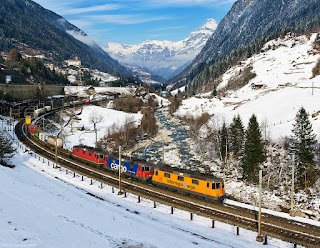The Gotthard Pass is one of those places I’d wanted to visit for some time, and that time finally arrived in October 2015. I’d previously noted that Switzerland is like a 1:1 model railway, with picture perfect mountain backdrops and not a weed or stick of dead grass to be seen; but the town of Wassen is something else.
The Pass itself is a major north-south freight route between Italy and the countries to the north, primarily Germany and The Netherlands. On each side of the pass, continuous steep grades, dozens of tunnels, countless bridges and multiple loops and horseshoes allow the track to gain enough altitude to reach a 15km long summit tunnel. The ‘North Ramp’ following the Reuss river between Erstfeld and the summit station of Göschenen is probably the most visited bit, and not far below the summit lies the railfan mecca of Wassen.
Here at either end of a tiny village, a pair of 180 degree horseshoe curves, almost entirely in tunnels, provide three levels of track that wind their way up the hillside, such that passengers pass the same church three times on various sides of the train as they travel the line. With plenty of trains and dozens of photo positions including the famous Wattinger Curve easily accessible with a little walking and climbing, I was hooked.
With a new 57km long(35 mile) basistunnel due to open underneath this spectacle in June 2016, the future for the old route is uncertain, so for the next few months its bound to be flooded by railfans like me hoping to catch a first or final glimpse of the line in its heyday. If you fancy a visit, there’s no time like today.
The only problem on my own trip, was the weather, with the sun threatening to make itself seen over the mountaintops between 11 and 3, but only managing to pop out from under mountain mists surrounding the deep valley for between zero and fifteen minutes on the three days I was there. As you’ll guess, this was usually when there were no trains to be had.
What an amazing place though. Exploring the hills, eating schnitzel with mushroom sauce, drinking appfelwijn (cider) and watching the chunky old electric locos snaking their trains around the old town was an incredible experience.
I just had to go back.
Booking a second visit in February in the hope of getting some sun seemed like a bad idea, with the forecast promising a week of miserable weather as the date approached. Indeed the trip down from Zurich was made in light drizzle and the next day that drizzle turned to rain and then snow. On the plus side, sun sometimes follows snow, and lo and behold the next day dawned clear, so I was up at the ‘command post’ overlooking Wassen for sun-up and spent one of my most memorable days ever photographing trains.
Towards the end of my first visit I wondered whether it might be possible to model some part of the Pass, preferably Wassen of course, in Z scale… I've never modeled in Z, but had collected a bit of track and US rolling stock for another project that never materialised.... And that’s what brings us here.




















































